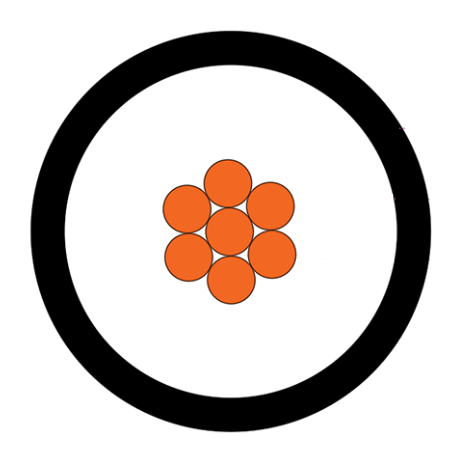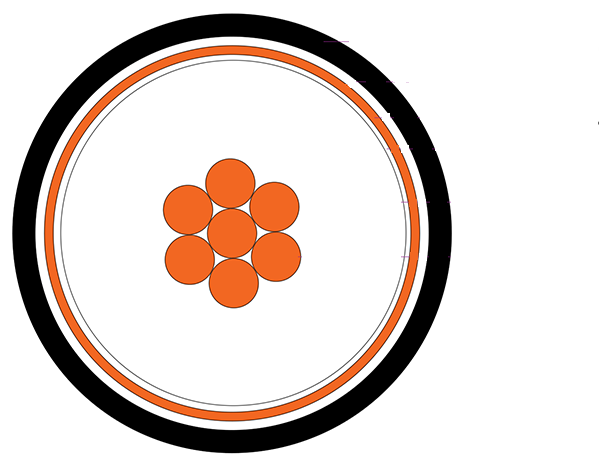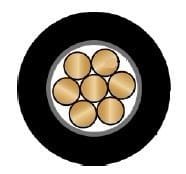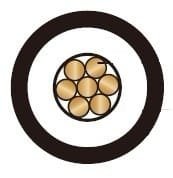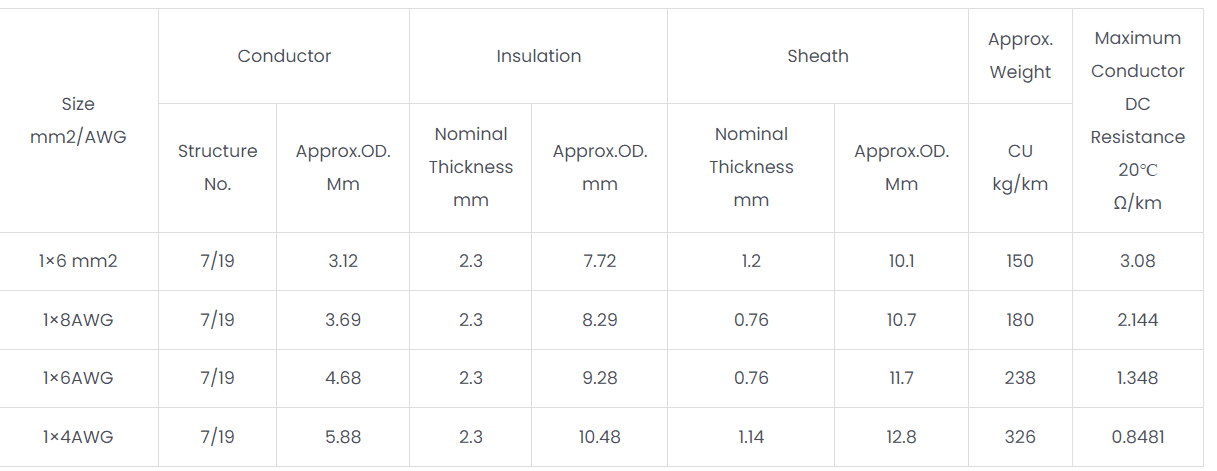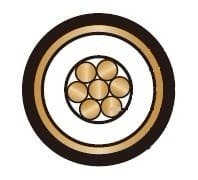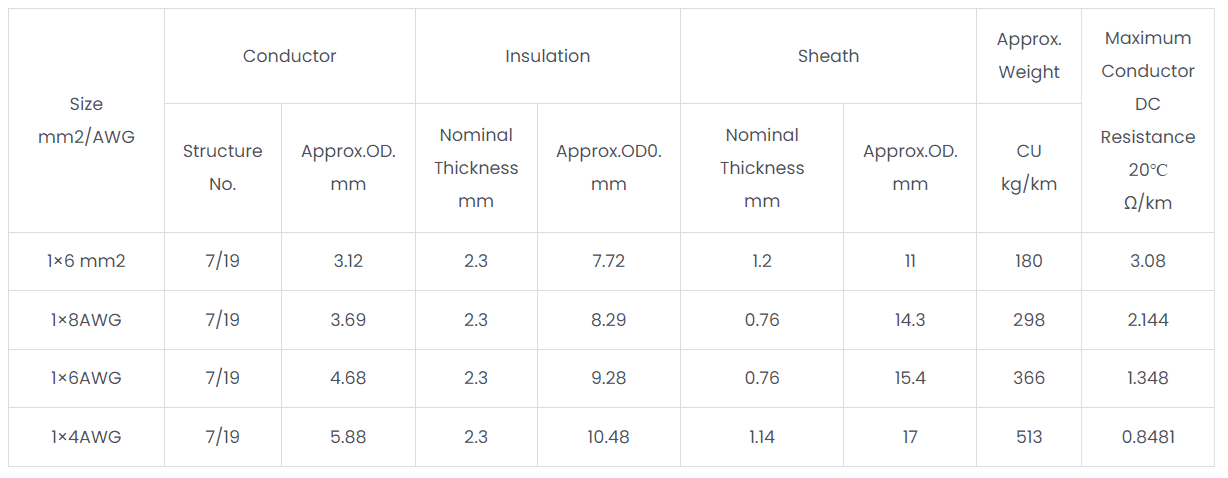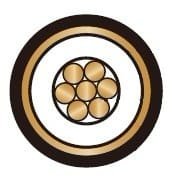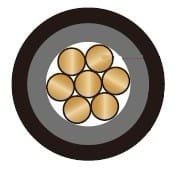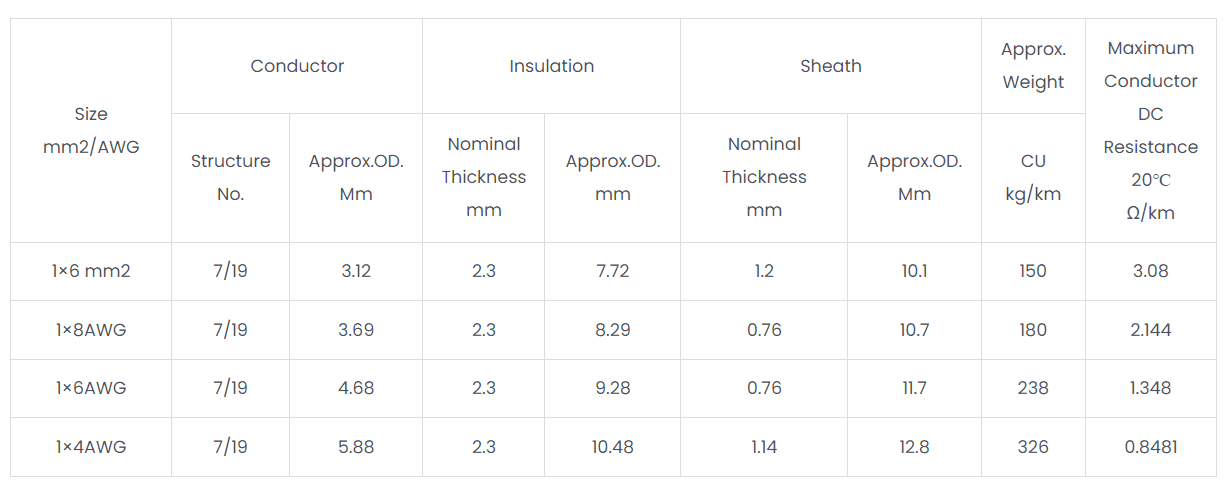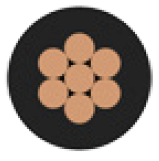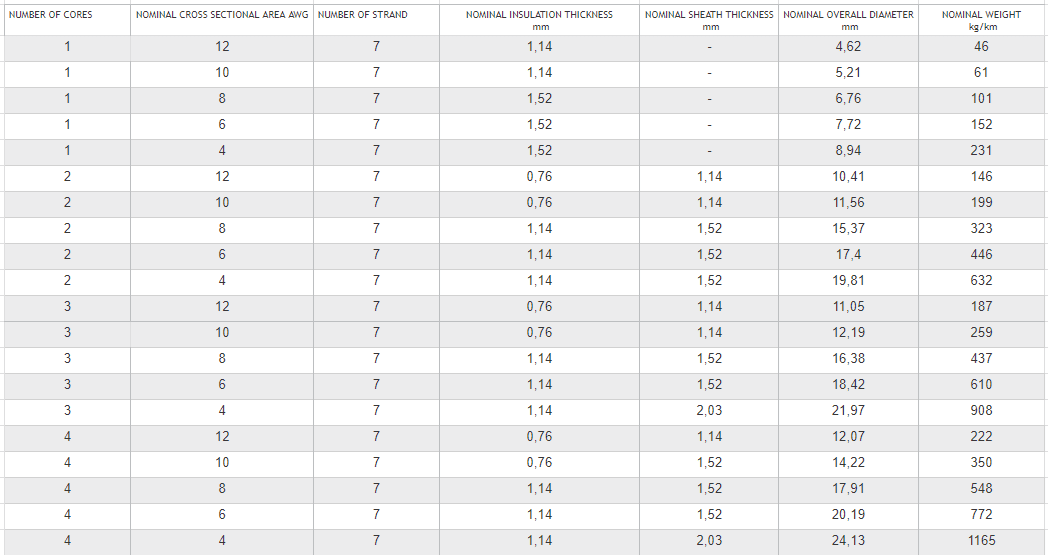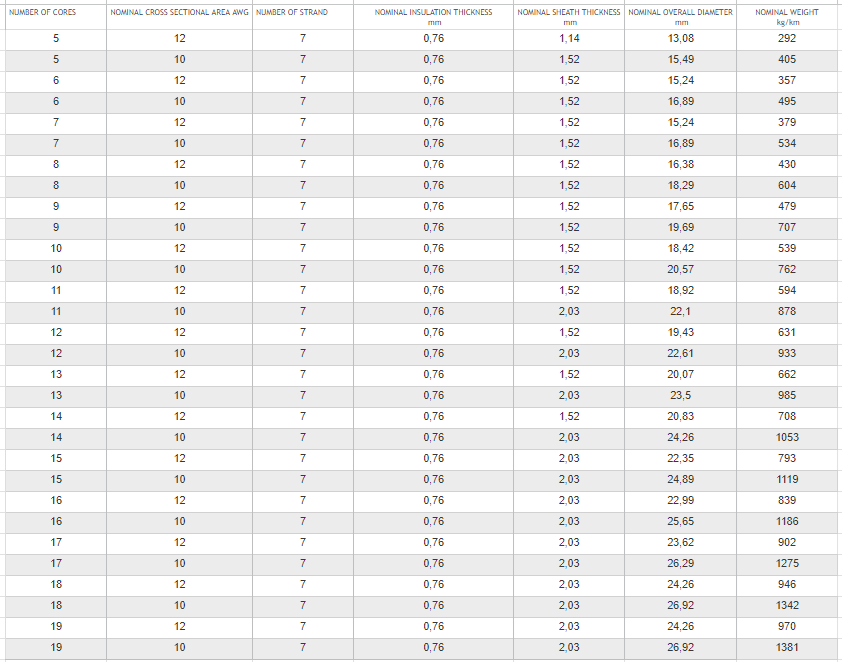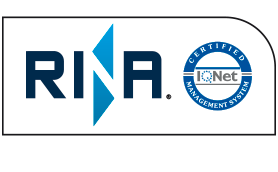AIRPORT SIGNALING CABLES
Cabos Airport
INNOVCABLE AIRPORT CABLE FOR LIGHT AID – NBR 7732 3.6/6kv SB
-Conductor material: Stranded conductor formed by bare electrolytic copper wires, soft temper, class 2 NBR NM 280 stranding.
– Conductor class: class 2 NBR NM 280 stranding.
– Vein Insulation: EPR/B elastomeric compound or cross-linked polyethylene XLPE in natural color.
– External cover in PVC/ST2 105 °C.
– Manufactured in black RAL 9005, or another color upon customer request.
– Nominal voltage: 3.6/6Kv.
– Conductor resistance: in accordance with DIN VDE 0295 class 2 and IEC 60228 cl. 2
Identification
INNOVCABLE AIRPORT CABLE 3.6/6Kv XX mm² NBR 7732 OF: XXXX/YEAR
Applicable Specifications
Applications
Flooring cable for application in light airport aid. Isolation with high dielectric stiffness ensures reliability to the electrical systems of the taxi, landing and takeoff slopes present at airports. These cables have flame resistance characteristics and auto extinction of fire, found through the NM-IEC 60332-1 test.
Maximum Conductor Temperature
Maximum temperature at steady state: 90°C;
Maximum overload temperature: 130°C;
Maximum short-circuit temperature: 250°C.
Notes
- We can produce beacon cable under consultation, several other options and cable settings. InnovCable reserves the right to change this catalog without any notice.
INNOVCABLE AIRPORT CABLE FOR LIGHTING AID – NBR 7732 3.6/6kv SHIELDED BT/BFC
-Conductor material: Stranded conductor formed by bare electrolytic copper wires, soft temper, class 2 NBR NM 280 stranding.
– Conductor class: class 2 NBR NM 280 stranding.
– Vein Insulation: EPR/B elastomeric compound or cross-linked polyethylene XLPE in natural color.
– Shielding in copper tape (BFC) or copper mesh (BT).
– External cover in PVC/ST2 105 °C.
– Manufactured in black RAL 9005, or another color upon customer request.
– Nominal voltage: 3.6/6Kv.
– Conductor resistance: in accordance with DIN VDE 0295 class 2 and IEC 60228 cl. 2
Identification
INNOVCABLE AIRPORT CABLE 3.6/6Kv BT OR BTC XX mm² NBR 7732 OF: XXXX/YEAR
Applicable Specifications
Applications
BASKING CABLE FOR APPLICATION IN LIGHT AVERAGES OF AIRPORTS. Isolation with high dielectric stiffness ensures reliability to the electrical systems of the taxi, landing and takeoff slopes present at airports. These cables have flame resistance characteristics and auto extinction of fire, found through the NM-IEC 60332-1 test.
Maximum Conductor Temperature
Maximum temperature at steady state: 90°C;
Maximum overload temperature: 130°C;
Maximum short-circuit temperature: 250°C.
Notes
- We can produce beacon cable under consultation, several other options and cable settings. InnovCable reserves the right to change this catalog without any notice.
INNOVCABLE AIRPORT CABLE FAA L-824 C UNSHIELDED 5KV
– Conductor: Class B Copper in accordance with ASTM B3, B8 and B33
– Semiconductor layer: Extruded semiconductor layer or helically applied semiconductor tape
– Insulation: Cross-linked Polyethylene (XLPE) or EPR/B.
– Manufactured in black RAL 9005, or another color upon customer request (green, blue, red, etc.).
– Nominal voltage: 5.0 KV
Identification
INNOVCABLE __ X AWG 5000V XLPE 90{D}C FAA-L824, TYPE C UNSHIELDED
Applicable Specifications
Applications
Airport lighting beacon is built for underground use according to (FAA) L-824 C requirements for airport lighting circuits (AC 150/5345-53d), (AC 150/5345-7F). The airport cable is available from #8 AWG to #4 AWG. Nu Class B recipped copper conductors, isolated with covered polyethylene XLPE or EPR/B resistant to abrasion, moisture and heat. Airport lighting cable is mainly used for series lighting circuits for tracks, control systems and other multifunctional installations. It can be used in direct burial, conduit or channels.
Maximum Conductor Temperature
– Normal operating temperature: +90° C
– Emergency operating temperature: +130° C
– Short circuit temperature: 250° C
Notes
- We can produce beacon cable under consultation, several other options and cable settings. InnovCable reserves the right to change this catalog without any notice.
INNOVCABLE AIRPORT CABLE FAA L-824 C (SHEATHED) 5KV
– Conductor: Bare stranded copper.
– Extruded semi-conductor compound.
– Insulation: Cross-linked polyethylene (XLPE) or EPR/B.
– Outer sheath: PE or PVC.
– Manufactured in black RAL 9005.
– Nominal voltage: 5.0 KV
Identification
INNOVCABLE __ X AWG 5000V
Applicable Specifications
Applications
Airport Lighting Cable is constructed for underground use in accordance with the requirements of (FAA) L-824 C for Airport Lighting Circuits ((AC 150/5345-7F). Airport cable is available from #8 AWG through #4 AWG .Class B bare annealed copper conductors, insulated with abrasion, moisture and heat resistant cross-linked polyethylene XLPE or EPR/B. mainly for series lighting circuits for runways, control systems and other multifunctional installations. It can be used in direct burial, conduit or raceways.
Maximum Conductor Temperature
– Normal operating temperature: +90° C
– Emergency operating temperature: +130° C
– Short circuit temperature: 250° C
Notes
– We can produce, upon request, several other options and cable configurations. Innovcable reserves the right to change this catalog without prior notice.
INNOVCABLE AIRPORT CABLE FAA L-824 C SHIELDED 5KV
– Conductor: Bare Braided Copper.
– Semiconductor layer: Extruded semiconductor layer.
– Insulation: Cross-linked Polyethylene (XLPE).
– External semiconductor layer: Helically applied or extruded semiconductor tape.
– Shielding: Shielded in copper tape or tinned copper mesh.
– External Cover: PVC. PE/XLPE can be offered upon request.
– Manufactured in black RAL 9005.
– Nominal voltage: 5.0 KV
Identification
INNOVCABLE __ X AWG 5000V XLPE 90 C FAA-L824, TYPE C SHIELDED
Applicable Specifications
Applications
Airport lighting cable is constructed for underground use in accordance with the requirements of (FAA) L-824 C for airport lighting circuits FAA AC 150/5345-7E, FAA AC150/5345-7F. Airport cable is available from #8 AWG to #4 AWG. Class B bare annealed copper conductors, insulated with XLPE or EPR/B cross-linked polyethylene resistant to abrasion, humidity and heat. Airport lighting cable is mainly used for series lighting circuits for runways, control systems and other multi-functional installations. It can be used in direct burial, conduit or channels.
Maximum Conductor Temperature
– Normal operating temperature: +90° C
– Emergency operating temperature: +130° C
– Short circuit temperature: 250° C
Notes
– We can produce, upon request, several other options and cable configurations. Innovcable reserves the right to change this catalog without prior notice.
INNOVCABLE AIRPORT CABLE FAA L-824 B SHIELDED 5KV
– Conductor: Bare Braided Copper.
– Insulation: EPR.
– Semiconductor layer: Semiconductor tape applied helically.
– Shielding: Shielded in copper tape.
– Separator: Separator tape
– External Cover: CPE.
– Manufactured in black RAL 9005.
– Nominal voltage: 5.0 KV
Identification
INNOVCABLE __ X AWG 5000V EPR 90 C FAA-L824, TYPE B SHIELDED
Applicable Specifications
Applications
Airport lighting cable is constructed for underground use in accordance with the requirements of (FAA) L-824 B for airport lighting circuits FAA AC150/5345-7F. Class B bare annealed copper conductors, insulated with EPR resistant to abrasion, moisture and heat. Airport lighting cable is mainly used for series lighting circuits for runways, control systems and other multi-functional installations. It can be used in direct burial, conduit or channels.
Maximum Conductor Temperature
– Fixed use temperature: -40°C to +85°C
– Maximum conductor temperature in normal operation:≤90℃
Notes
– We can produce, upon request, several other options and cable configurations. Innovcable reserves the right to change this catalog without prior notice.
INNOVCABLE AIRPORT CABLE FAA L-824 B UNSHIELDED 5KV
– Conductor: Bare stranded copper.
– Insulation: EPR.
– Outer sheath: CPE/PVC.
– Manufactured in black RAL 9005.
– Nominal voltage: 5.0 KV
Identification
INNOVCABLE __ X AWG 5000V EPR 90 C FAA-L824, TYPE B UNSHIELDED
Applicable Specifications
Applications
Airport lighting cable is constructed for underground use in accordance with the requirements of (FAA) L-824 B for airport lighting circuits FAA AC150/5345-7F. Airport cable is available from #8 AWG to #4 AWG. Class B bare annealed copper conductors, insulated with EPR resistant to abrasion, moisture and heat. Airport lighting cable is mainly used for series lighting circuits for runways, control systems and other multi-functional installations. It can be used in direct burial, conduit or channels.
Maximum Conductor Temperature
– Fixed use temperature: -40°C to +85°C
– Maximum conductor temperature in normal operation:≤90℃
Notes
– We can produce, upon request, several other options and cable configurations. Innovcable reserves the right to change this catalog without prior notice.
INNOVCABLE AIRPORT CABLE FAA L-824 C 600V
– Conductor: Bare Braided Copper according to ASTM B
– Insulation: XLPE or EPR/B
– External Cover: PVC (only for multiconductors).
– Manufactured in black RAL 9005.
– Nominal voltage: 600 V
Identification
INNOVCABLE __ X AWG 600V EPR/B 90 C FAA-L824, TYPE C
Applicable Specifications
Applications
Airport lighting cable is constructed for underground use in accordance with the requirements of (FAA) L-824 C for Airport Lighting Circuits FAA AC150/5345-7F. Class B bare annealed copper conductors, insulated with XLPE or EPR/B resistant to abrasion, humidity and heat. Airport lighting cable is mainly used for series lighting circuits for runways, control systems and other multi-functional installations. It can be used in direct burial, conduit or channels.
Maximum Conductor Temperature
– Fixed use temperature: -40°C to +90°C
– Maximum conductor temperature in normal operation:≤90℃
Notes
– We can produce, upon request, several other options and cable configurations. Innovcable reserves the right to change this catalog without prior notice.
Research and Knowledge Centers
In order to stand out and lead through state -of -the -art research, InnovCable closely follows the advances and innovations developed by important centers of excellence and research in the electricity sector, with special attention to the area of cables, both in Brazil and in the international scenario.
Next, we present some of the main centers of knowledge that are a reference for our work:
Innovcable Knowledge Bases
- Knowledge Academy: Application and Installation of Moveable Cables - Rolante Bridge, Currency, Festoons, Elevators, Crane Treadmills…
- InnovCable Furniture Guide: What mobile cables do you use?
- Why use InnovCable Mobile Cables: Considerations of why utilize mobile cables
- Cable storage and transportation guidelines
- GLOSSARY: Technical Terms in English
- Color Code Tables: According to DIM47100, BS4737, BS5308
- Copper Temperature Coefficients: Constant to convert resistance at various temperatures to the standard 20 ° CE reference temperature of constants to convert resistance to 20 ° C other temperatures.
- MISCELLANEOUS METAL DATA
- Tables: Cenelec - VDE
- Dimensioning tables: power cables - NBR 5410
- COMPENSATION AND EXTENSION THERMOCOUPLE CABLES AND WIRE TABLES
- Driver Class : mm² x AWG
- Diverse technical information
- Naval cable codes and nomenclatures as per Nek606
- SHF1 AND SHF2 COVERS ACCORDING TO NEK-606
- Resistance of insulation and cover materials, comparative of properties
- Resistance from Armação / Armor Resistance
- Current classifications and voltage drop vol 1 - IEE
- Current classifications and voltage drop Vol 2 - IEE
- Fire Performance Standards: Fire Performance Cable Standards
- Radius of minimum allowed curvature: according to DIN VDE 0298 PART 3
- STANDARDS
- Voltage Fall Calculations: VoltaGe Drop Calculations
Databases and academic search mechanisms
- IEEE Xplore Digital Library: IEEE
- ACM Digital Library: ACM
- ScienceDirect: SCIENCE DIRECT
- Scopus: SCOPUS
- CAPES Journal Portal: CAPES
- Google Scholar: GOOGLE SCHOLAR
Prominent journals and journals
- IEEE TRANSACTIONS ON POWER SYSTEMS: (Available through IEEE XPLORE)
- IEEE TRANSACTIONS ON POWER DELIVERY: (Available through IEEE XPLORE)
- IEEE TRANSACTIONS ON COMMUNICATIONS: (Available through IEEE XPLORE)
- Telecommunications Magazine (Inatel): INATEL
- Control & Automation Magazine (SBA): SBA
- Directory of Open Access Journals (DOAJ): DOAJ
Institutional repositories and research groups
- Brazilian Digital Library of Theses and Dissertations (BDTD): BDTD
- GEPOC – Power Electronics and Control Group (UFSM): GEPOC
Technical standards entities
These organizations are responsible for developing and publishing the standards that guarantee the safety, quality and interoperability of electrical cables and communication.
- ABNT (Brazilian Association of Technical Standards): It is the National Forum of Standardization in Brazil. ABNT standards, such as NBR 5410 (low voltage electrical installations), are fundamental for any project in the country.
- ABNT
- To consult the collection: ABNT COLLECTION
- IEC (International Electrotechnical Commission): The International Electrical Commission is the world leading organization in the elaboration and publication of international standards for all electrical, electronic and related technologies. Many ABNT standards are based on IEC standards.
- ISO (International Organization for Standardization): Although it is a standardization organization for a wide range of industries, ISO also publishes relevant rules for the cable sector, especially related to Quality Management Systems (ISO 9001).
- UL (Underwriters Laboratories): A global security science organization, well known for its product certifications. UL standards are an important security reference, especially for products for the US market.
- Aunt (Telecommunications Industry Association): Main Association for the Information and Communication Technology Industry (ICT). Develops structured cabling standards, such as the ASI/TIA-568 series, which are a world reference for communication networks.
Associations, unions and regulatory entities
These organizations represent the interests of industry, promote quality and regulate the sector.
- Anatel (National Telecommunications Agency): It is the regulator of the telecommunications sector in Brazil. Anatel is responsible for approving and certification of telecommunications products, including network cables and fiber optics.
- Sindicel (Union of the Industry of Electrical Driver, Treflation and Lamination of Non -Ferrous Metals of the State of São Paulo): It represents industries in the sector, acting in defense of their interests and promoting actions to combat the illegal cable market.
- Qualifio (Brazilian Association for the Quality of Electric Wires and Cables): Entity that monitors the quality of the electricized wires and cables sold in Brazil, maintaining a list of approved and non -compliance manufacturers.
- Abinee (Brazilian Association of Electric and Electronic Industry): It represents the electrical and electronic sectors nationally, acting on several fronts, including standardization and regulation issues.
- BICSI: A global professional association that supports the Information and Communication Technology (ICT) community. Provides education, certifications and publications of standards for design and installation of cabling systems.
- International Cablemakers Federation (ICF): Global Forum that brings together the CEOs of the world's leading wire and cable companies to discuss industry trends and challenges.
Research Giants: Ponta Universities in Brazil in the area of Electric Cables and Communication
Brazil has a robust ecosystem of public universities that are true references in research and development in the areas of electrical and communication engineering. Several of them house state -of -the -art laboratories and international recognition research groups that act directly with power cable themes, optical fibers, dielectric materials and communication systems.
Next, we highlight some of the top first -line universities and their respective centers of excellence on the subject:
1. State University of Campinas (Unicamp)
Main focus: Optical and photonic communications
Considered one of the largest telecommunications innovation centers in Latin America, Unicamp, especially through its Faculty of Electrical and Computing Engineering (FEEC) and the Gleb Wataghin Institute of Physics (IFGW), is an absolute leader in optical fiber research and communication systems. Proximity and historical collaboration with CPQD (Telecommunications Research and Development Center) solidifies its position.
- Laboratories and prominent groups:
- Optical and Microwave Communications Laboratory (Lapcom): Focused on research of optical amplifiers, doped fibers and electromagnetic wave propagation.
- Integrated Photonic Laboratory (LIF): It brings together various laboratories and researchers for the development of photonic devices, special optical fibers and communication systems.
- Group of ultra -rarefilled phenomena and optical communications (gfurco): Performs advanced studies on optical fibers, devices and phenomena at very high transmission speeds.
2. Federal University of Itajubá (Unifei)
Main focus: power systems and high voltage
Unifei is a historical reference and of great prestige in electrical power systems in Brazil. Its Institute of Electrical and Energy Systems (ISEE) is one of the most important in the country, with strong performance in studies involving power cables, electrical insulation and energy transmission.
- Laboratories and prominent groups:
- High voltage laboratory (lat-efei): One of the most renowned in the country, performs tests and high voltage tests on cables, insulators and other electrical systems equipment. It is pioneering and fundamental for the development of the national electricity sector.
- Link: LAT-EFEI
- Institute of Electrical and Energy Systems (ISEE): It brings together various laboratories and research groups in areas such as system protection, energy quality and automation, all intrinsically linked to the performance and application of electrical cables.
- High voltage laboratory (lat-efei): One of the most renowned in the country, performs tests and high voltage tests on cables, insulators and other electrical systems equipment. It is pioneering and fundamental for the development of the national electricity sector.
3. University of São Paulo (USP)
Main focus: power systems, power electronics and telecommunications
USP, with its multiple campuses, has extremely strong and diverse research. Both the Polytechnic School (POLI-USP) in São Paulo and the São Carlos School of Engineering (EESC-USP) have excellence laboratories and research groups that work on cable related topics.
- Laboratories and prominent groups:
- High voltage laboratory (EESC-USP): Located in São Carlos, it works in the study of high voltage phenomena, insulating materials and electrical discharges.
- EESC-USP (See LAT in the list)
- Research Laboratory in Electrical Systems Protection and Automation (POLI-USP): Develops research in electrical systems protection, where modeling and cable behavior in absences are essential.
- Telecommunications Laboratory (EESC-USP): With groups dedicated to microwave and optics, develops research relevant to the communication cables area.
- EESC-USP (See TELECOM in the list)
- High voltage laboratory (EESC-USP): Located in São Carlos, it works in the study of high voltage phenomena, insulating materials and electrical discharges.
4. Federal University of Santa Catarina (UFSC)
Main focus: power electronics and energy systems
UFSC is a hub of excellence recognized worldwide in power electronics. Developed research is crucial for cable application to energy conversion systems, engines and renewable sources connection.
- Laboratories and prominent groups:
- Institute of Power Electronics (INEP): One of the most productive research groups in the world in the area. Develops state -of -the -art technology for converters and power inverters, which connect through cables to various loads and sources.
5. Federal University of Minas Gerais (UFMG)
Main focus: Telecommunications and Applied Electromagnetism
UFMG has a consolidated postgraduate program in Electrical Engineering, with research groups relevant to the area of communication and electromagnetism, which give the theoretical and applied base for the development of cable and wave guides technologies.
- Laboratories and prominent groups:
- Department of Electronic Engineering (DELT): It has research laboratories in telecommunications and networks, where it is studied from fiber optic communication to wireless communication systems, which often depend on a robust wable infrastructure.
Research Institutes
National scenario
1. CPQD (Telecommunications Research and Development Center) - Brazil
Main focus: Information and Communication Technologies (ICT)
Headquartered here in Campinas, CPQD is the largest ICT Research Institute in Latin America and a key piece in the history of Brazilian telecommunications. It develops from optical component technology to full software and hardware platforms for 5G/6G networks, IoT and cyber security. For a communication engineer, it is a mandatory reference.
- Relevant areas and platforms:
- Optical communications: Poor research on photonic devices, special optical fibers and high capacity transmission systems.
- Wireless connectivity: Systems development and testing for 5G, 6G and Open Ran.
- Validation and tests: Accredited laboratories for testing and equipment certification, including cables and components, for compliance with Anatel standards.
2. CEPEL (Electricity Research Center) - Brazil
Main focus: generation, transmission and distribution of electricity
CEPEL is the research arm of the Eletrobras Group and the largest electrical research institute of the southern hemisphere. Its performance is vital to the safety and evolution of the National Interconnected System (SIN). CEPEL research on high voltage equipment, materials and systems have a direct impact on the specifications and operation of power cables.
- Areas and prominent groups:
- EQUIPMENT AND MATERIAL LABORATORY (LEM): Performs high voltage tests and high current in cables, transformers and other active electrical system.
- Link: CEPEL LEM
- Transmission Technologies: Research applied on transmission lines, substations and high voltage equipment, including cable behavior under extreme conditions.
- EQUIPMENT AND MATERIAL LABORATORY (LEM): Performs high voltage tests and high current in cables, transformers and other active electrical system.
3. Inmetro (National Institute of Metrology, Quality and Technology) - Brazil
Main focus: scientific and industrial metrology, compliance assessment
Although first a regulatory and metrology entity, Inmetro has very high level laboratories that conduct research to establish the country's measurement standards. Its scientific metrology and technology board is critical to ensuring that rehearsals in cables and other products are accurate and reliable throughout Brazil.
- Areas and prominent groups:
- Electric Metrology Laboratory (Label): Responsible for maintaining and disseminating national standards for electrical quantities, base for all cable tests.
- Link: INMETRO LABEL
- Electric Metrology Laboratory (Label): Responsible for maintaining and disseminating national standards for electrical quantities, base for all cable tests.
International scenario
1. Fraunhofer-Gesellschaft-Germany
Main focus: Applied research in multiple areas of engineering
Fraunhofer society is the largest applied research organization in Europe, with 76 institutes scattered throughout Germany. Each institute has a specific focus, and several are world references in the areas of communication and energy.
- Prominent institutes:
- FRAUNHOFER INSTITUTE FOR TELECOMMUNICATIONS (Heinrich Hertz Institute - HHI): World leader in fiber optic networks, photonic components, video compression (creators of patterns such as H.264/stroke and H.265/HEVC) and wireless communication.
- Link: HHI Fraunhofer
- FRAUNHOFER INSTITUTE FOR ENERGY ECONOMICS AND ENERGY SYSTEM TECHNOLOGY (IEE): Focused on energy transition, develops technology for renewable integration, smart networks and stability of power systems.
- Link: IEE Fraunhofer
- FRAUNHOFER INSTITUTE FOR TELECOMMUNICATIONS (Heinrich Hertz Institute - HHI): World leader in fiber optic networks, photonic components, video compression (creators of patterns such as H.264/stroke and H.265/HEVC) and wireless communication.
2. NIST (National Institute of Standards and Technology) - USA
Main focus: science of measurement, standards and technology
North American equivalent of Inmetro, but with an even more comprehensive performance in fundamental and applied research. The NIST is crucial for US technological development, creating standards and measurement technologies that allow innovation throughout the industry.
- Laboratories and prominent groups:
- Communications Technology Laboratory (CTL): Develops fundamental research in metrology for 5G/6G networks, network resilience and quantum communication.
- Material Measurement Laboratory (MML): Conducts research on material properties, including polymers used in cable isolation and advanced electronics materials.
3. NIC (National Institute of Information and Communications Technology) - Japan
Main focus: Information and Communication Technologies
NICT is Japan's main public research institute in the ICT area. It is known for its record -compliance with fiber optic transmission, having shown the highest transmission rates in the world on several occasions, as well as strong research on quantum and security networks.
- Prominent groups and initiatives:
- Photonic Network System Laboratory: Research Ultra-High Capacity Optical Transmission Systems, exceeding the boundaries of what is possible in a single optic cable.
4.
Main focus: microelectronics, nanotechnology and photonic in silicon
Leti is an institute of the Commissioner of Atomic Energy and Alternative Energy (CEA) of France and a global leader in miniaturization of technologies. They are pioneers in “photonic silicon”, which seeks to integrate optical components directly into silicon chips, a revolution for short and medium distance communications.
- Prominent groups and initiatives:
- Optics and Photonics Division: Develops from image sensors to optical communication systems and dealing integrated in chips, impacting the future of communication cables on data centers and high performance computing.
These institutions represent the forefront of academic research in the sector, training highly qualified professionals and developing technology that drives the entire cable industry.


